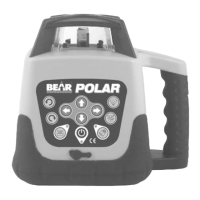— 21 —
(Note: it is best to use the remote control for the next 2 steps but you can gently press the buttons on the laser control panel)
7. Press the auto/manual button to enter manual mode.
8. Use the manual grade arrow buttons to tilt the plane of light (as per chapter 3.7) until the
“slope” reading at Point A is equal to the reading calculated in point 6 above.
9. Perform steps 3 to 8 in the opposite axis for dual grade applications.
Note: If you do not have a staff to take an initial “level” reading, instead of performing steps 5, 6, & 8 above, simply
make a “level” mark on a stake at Point A and then tilt the plane of light as in point 8 above until the difference
between the “slope” reading at Point A and the original “level” reading at Point A is equal to the Height Differential as
calculated in point 4 above.
If using a Genno-Rod, you can follow the same principle as long as the Height Differential is less than 0.500m.
Simply set the “level” reading as your zero datum point on the cut & ll side of the Genno-Rod at Point A and then tilt
the plane of light as in point 8 above until the difference between the “slope” reading at Point A and the original “level”
reading at Point A is equal to the Height Differential as calculated in point 4 above.
9. Ensure the Genno Rod is truly vertical (use inbuilt bubble) otherwise grades will be incorrect.
Example 1: You desire a positive 2% slope and your level reading is 1.563m on a staff that is
10m from your laser.
Eg: +2% Slope with Point A 10 metres from the laser. (Note: 2% = 2/100)
Height Differential = (slope %) x (distance)
= (2%) x (10m)
= (2/100) x (10m)
= 0.200m
To establish your required “slope” reading on the staff add the Height Differential to the original
“level” reading:
Required “slope” reading on staff = original “level” reading + Height Differential
= 1.563m + 0.200m
= 1.763m

